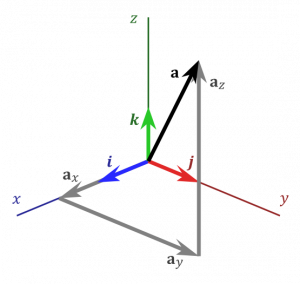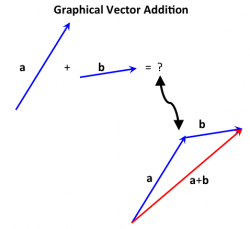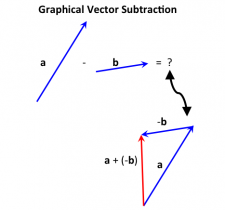This is an old revision of the document!
Scalars and Vectors
Definitions
Scalars: Quantities that can be represented by a single number. Typical examples include mass, volume, density, and speed.
 Vectors Quantities than have both a magnitude and direction. Typical examples include displacement, velocity, momentum, and force.
Vectors Quantities than have both a magnitude and direction. Typical examples include displacement, velocity, momentum, and force.
Vectors are often represented with arrows. The end with the triangle is the “tip” or “head”. The other end is called the “tail”. The tail of a vector can be located anywhere; it is the difference between the tip and the tail that defines the vector itself.
Defining Vectors Mathematically
 We define vectors in three dimensional space relative to some origin (where the tail of the vector is located). For example, a position vector $\vec{r}$ might defined relative to the origin of coordinates. The measures of the vector along the coordinate axes are called the vector's “components”, which can be positive or negative. Mathematically, a vector is often written with bracket notation:
We define vectors in three dimensional space relative to some origin (where the tail of the vector is located). For example, a position vector $\vec{r}$ might defined relative to the origin of coordinates. The measures of the vector along the coordinate axes are called the vector's “components”, which can be positive or negative. Mathematically, a vector is often written with bracket notation:
$$ \vec{r} = \langle r_x, r_y, r_z \rangle $$
where $r_x$, $r_y$, and $r_z$ are the vector components in the $x$, $y$, and $z$ direction respectively. They tell you “how much” of the vector $\vec{r}$ is aligned with each coordinate direction.
In physics, we often use $\vec{r}$ to represent the position vector, that is, the location of an object with respect to another point (origin).
Length of a vector
The magnitude (or length) of a vector is a scalar quantity. Mathematically, we represent the magnitude of a vector like this:
$$r = | \vec{r} | = \sqrt{r_x^2+r_y^2+r_z^2}$$
This is the Pythagorean theorem in three dimensions.
Unit vector
Any vector can be multiplied or divided by a scalar quantity. Often it is useful to divide a vector by its own magnitude. The result is the unit vector. A vector with length 1 and not units, but that points in the direction of the original vector. Mathematically, we represent the unit vector like this:
$$ \hat{r} = \dfrac{\vec{r}}{|\vec{r}|} = \dfrac{\langle r_x, r_y, r_z \rangle}{\sqrt{r_x^2+r_y^2+r_z^2}}$$
With a unit vector, any vector can be written as a product of its magnitude and its unit vector.
$$ \vec{r} = |\vec{r}|\hat{r} $$
While in physics we often represent vectors using brace notation ($ \vec{r} = \langle r_x, r_y, r_z \rangle $), other forms you might see include coordinate unit vectors: $\vec{r} = r_x\hat{x}+r_y+\hat{y}+r_z\hat{z}$, $\vec{r} = r_x\hat{i}+r_y+\hat{j}+r_z\hat{k}$, and $\vec{r} = r_x\hat{e}_1+r_y+\hat{e}_2+r_z\hat{e}_3$. These unit vectors point along coordinate directions.
2D Vectors
Two dimensional vectors are easy to sketch, so often we will use them when describing problems. For these vectors it is often useful to define an angle ($\theta$) between the vector and one of the coordinate directions (see the figure to the right). The typical relationship between the x and y components of a 2D vector and its magnitude and this angle (when defined from the positive x-axis) is:
$$ r_x = |\vec{r}| \cos \theta $$ $$ r_y = |\vec{r}| \sin \theta $$
Adding & Subtracting Vectors
Vector addition and subtraction can be done mathematically and graphically. Mathematically, vector addition and subtraction is done component by component like this:
$$ \vec{a} +\vec{b} = \langle a_x, a_y, a_z \rangle + \langle b_x, b_y, b_z \rangle = \langle a_x+b_x, a_y+b_y, a_z+b_z \rangle $$
$$ \vec{a} - \vec{b} = \langle a_x, a_y, a_z \rangle - \langle b_x, b_y, b_z \rangle = \langle a_x-b_x, a_y-b_y, a_z-b_z \rangle $$
 Graphically, vector addition and subtraction use the “tip-to-tail” method. For addition, place the tail of the second vector at the tip of the first vector. The vector that points from the tail of the first to the tip of the second is the sum or the “resultant” vector.
Graphically, vector addition and subtraction use the “tip-to-tail” method. For addition, place the tail of the second vector at the tip of the first vector. The vector that points from the tail of the first to the tip of the second is the sum or the “resultant” vector.
 For subtraction, draw the vector that points directly opposite of the second vector. Place the tail of this reversed second vector at the tip of the first vector. The vector that points from the tail of the first to the tip of the reversed second is the difference vector.
For subtraction, draw the vector that points directly opposite of the second vector. Place the tail of this reversed second vector at the tip of the first vector. The vector that points from the tail of the first to the tip of the reversed second is the difference vector.
Vector Simulation
Here's simulation that let's you play with vectors in 2D. If the embedded simulation doesn't work, you can find it on the PhET website.
